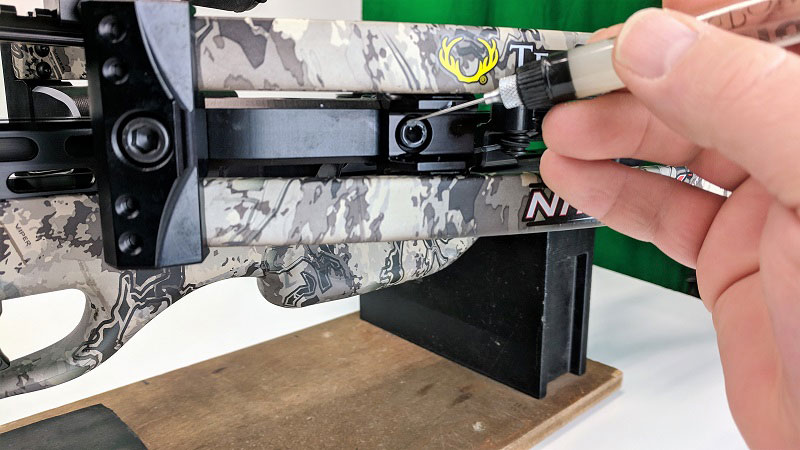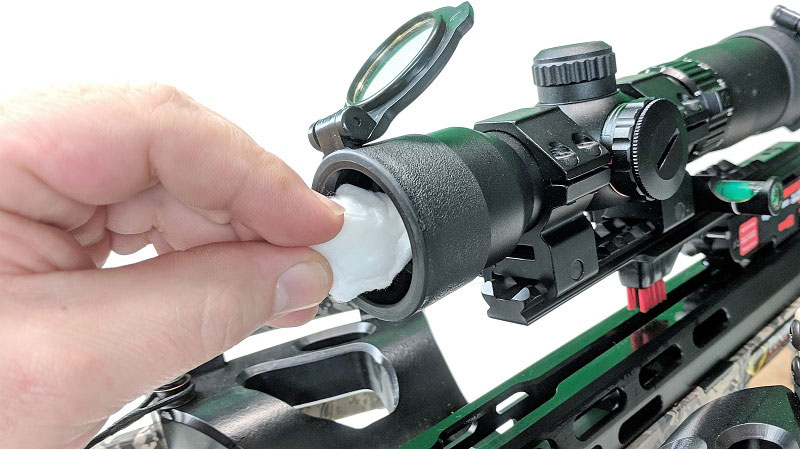Archery deer hunting seasons in most states are now closed or finishing up soon. Hopefully, you had a successful harvest with your crossbow this past season. Remember, before you store your crossbow away for the winter, there are some things to take care of so that it will be ready to go next season. Here are 10 maintenance tips that you should follow to prep your crossbow for off-season storage:
1. Wipe surface dirt and grime from the crossbow.
Check over your crossbow to determine if you need to remove any surface dirt, dust or grime. If you were hunting when it was damp outside, you will likely have some dried mud on the foot stirrup, riser or even the underside of the stock and flight rail. To clean the surfaces on the crossbow, you should use a cotton towel and purified water only. A cotton towel is best because the cotton is nonabrasive and will not scratch any of the crossbow’s parts. Using water only is critical because cleaning agents or solvents may react with the hydro-dipped camouflage coating on the stock or limbs and cause it to flake or peel – something that is not covered under the warranty in most cases. Wring out the towel prior to wiping, as you do not want excess water to drip onto any of the steel parts. If you do not have a cotton towel, you can substitute it with cotton balls or cotton swabs. After you have wiped the surfaces clean, you can use a hair dryer or set the crossbow in front of a fan to dry out the parts completely.
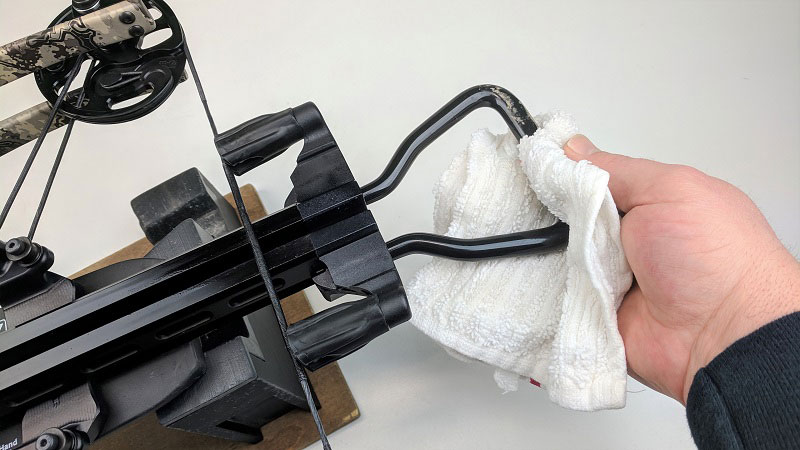
Use only purified water and a cotton towel to clean dirt and dust from the surfaces of the crossbow. (Author photo)
2. Check all nuts, bolts and screws for tightness.
A great deal of energy travels through your crossbow during every shot. This energy wave causes the crossbow’s parts to vibrate, which can lead to loosening of the nuts, bolts and screws over time. Periodically checking to make sure that everything is tight on the crossbow is a good maintenance habit to develop throughout the season. Performing a final check before storing your crossbow will ensure that all parts are tight and secure, and that your crossbow will be ready to go when you take it out in the spring or summer for practice sessions.
3. Apply rust-protective oil to all exposed nuts, bolts, screws and steel parts.
Your crossbow has many nuts, bolts and screws that hold it together. Most of these are made from steel, which will rust if not oiled periodically. It is amazing how fast these parts can rust – anyone who has left their crossbow outside overnight when it is damp can attest to this fact. When the crossbow is exposed to damp conditions or if it is stored in a damp location, rust can begin to appear on the steel parts within 24 hours of being exposed. Applying oil to these parts prior to storage is essential. Many crossbow owners use cotton swabs to apply the oil to the bolt heads and other parts because it allows you to be very precise and careful when applying. Again, some types of rust-protective oil contain chemicals that can react with the hydro-dipped camouflage and cause it to peel or flake. Some oils can also cause premature wear on the string or cable end-loops due to deterioration from the oil. Applying the oil first to the head of a cotton swab and then using the swab to apply it to the bolts also helps to ensure that you get complete surface area coverage and that there is no excess oil to run or drip onto other parts of the crossbow.
4. Apply oil to the trigger mechanism, axles and cam bearings.
To oil the trigger mechanism on a TenPoint, Wicked Ridge or Horton by TenPoint-manufactured crossbow, slide the safety knob to the rear white “Safe” position. Apply one drop of oil to both sides of the safety slide through the safety knob window in the trigger box. Cycle the safety mechanism forward and backward multiple times to ensure that the oil spreads evenly over the internal parts that contact the safety slide. Again, with the safety knob in the “Safe” position, apply one drop of oil to the string latch through the string slot in the trigger box and cycle the safety knob forward and backward to ensure coverage. To lubricate the axles and cam bearings, apply one drop of oil to the top of each cam where the axle and bearings pass through. Use a cotton swab to wipe away any excess oil from the parts you have oiled in the trigger box or on the cams. If you do not have a TenPoint, Horton or Wicked Ridge crossbow, consult your manufacturer’s specific instructions for maintaining your trigger mechanism.
5. Wax and condition your string and cables.
If your crossbow has exposed strands of the string or cables that are not served, then a coating of bowstring wax should be applied to the exposed strands. Using a heat source, melt or soften the end of your piece of wax and apply some to your thumb and index finger. While squeezing the strands between your thumb and index finger, move quickly back-and-forth over the strands until all of the wax has been transferred from your fingers to the strands. Some people cut a small leather square, apply the wax to the leather, and transfer the wax from the leather to the bowstring using the same motion. In either case, ideally you should feel some heat generated from friction with the strands, which will melt the wax and help it to soak into the fibers. For the sections of the string and cables that are served, apply Scorpion Venom Target Arrow Release Fluid to the servings and end-loops to keep them properly conditioned.
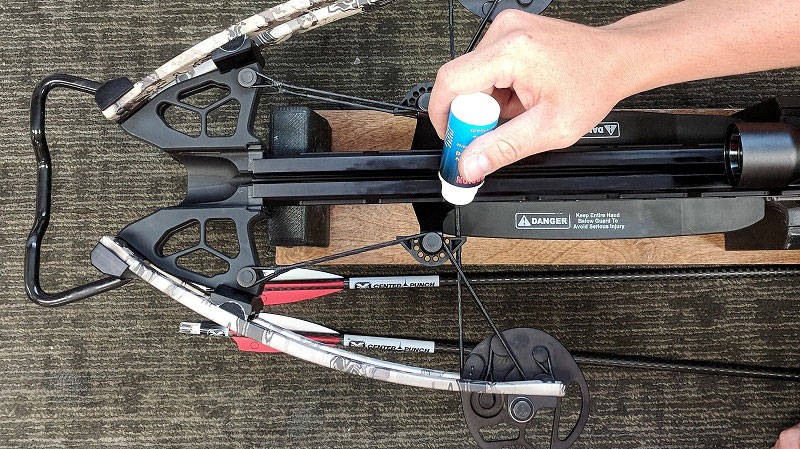
Apply wax to the string’s exposed strands and Scorpion Venom Target Arrow Release Fluid to the servings and end-loops. (Author photo)
6. Clean and clear any dirt or debris from the flight rail.
Dirt and debris can collect on top of the flight rail or down inside the flight groove after a season of hunting. Using a cotton towel and water, wipe the top surface of the flight rail from the nose of the trigger box all of the way down to the front of the bow, removing any dirt or excess flight rail lubricant that may remain. If you see debris down in the flight groove, you can use pressurized air to blow out any pieces you find, or you can use a cotton swab to sweep the debris out.
7. Check inside barrel cutouts for debris.
If your crossbow has an aluminum barrel with cutouts, check inside the barrel to see if any debris has collected there. You might find it helpful to use a flashlight to perform this inspection. Again, you can use pressurized air to blow out any pieces of debris that you find. You will also see some bolts that attach the stock to the barrel or attach the riser to the barrel and stock (in the case of a reverse-draw crossbow). Be sure to apply rust-protective oil to the bolts located inside the barrel. Use a cotton swab to apply the oil or to clean up any areas where you may have applied too much.
8. Thoroughly clean the scope lenses and lens covers.
Remove the lens covers from your scope and check the lenses for dust and grit. To clean the lenses, use a solution of purified water with one or two drops of dish detergent. This mild mixture is recommended because alcohol or other types of chemical glass cleaners may react with the coating on the lenses and damage them. Apply this solution with cotton balls and swabs. Cotton balls are nonabrasive and will not scratch the lenses — as long as you remove as much dust as you can from the lenses prior to wiping them. To remove the surface dust, wet a cotton ball in the solution and squeeze it out like a sponge. Dab (do not wipe) the cotton ball onto the lens to remove the particles. If you notice that you have picked up a lot of particles, throw that cotton ball away and use another. Once most of the particles are removed, dip the cotton swab in the solution and dab around the circumference of the lens where it meets the scope bell. This will remove any particles that may be wedged in this area. Next, use a clean cotton ball dipped in the solution to wipe the surface of the lens. Then, use another cotton ball dipped in plain water and wipe to remove any final residue left over by the detergent. Finish by first dabbing, then wiping the lenses with clean, dry cotton balls until the lenses are dry. Clean the lens covers by repeating this method.
9. Check, clean and lubricate the cocking mechanism.
If you are using a stock-integrated cocking mechanism like the ACUdraw, ACUdraw PRO, ACUdraw 50 SLED or ACUdraw 50, start by removing the covers from each side of the stock. Inspect the covers for cracks or damage and be sure to replace if necessary. Next, check the main frame of the cocking unit to make sure it is mounted properly in the stock and does not move. If the whole unit is loose, hand tighten the bolts that mount the frame to the stock to tightly secure it. Check the remaining bolts in the mechanism and hand tighten any that you find loose. Pay close attention to the small bolt that secures the ACUdraw/ACUdraw PRO cord to each hub. Also, check the bolts that hold the wire guides in place through which the cord travels in and out of the mechanism.
If you have an ACUdraw 50 SLED or ACUdraw 50, check the Allen or Phillips-head bolt that secures each hub to the unit. Inspect the cord(s) for any cuts, tears or broken strands and replace if needed. If the cord is fuzzy but you do not see any broken strands or cuts, apply some string wax to it (using the method described in Tip #5) to help prevent premature wear. Pull the hooks, handles, sled or claw out of the mechanism to check that you still have the right amount of spring tension in the unit, and that the hooks/handles or claw will retract back into the unit smoothly. If the action is not smooth or you do not have any spring tension, take the crossbow to your local dealer for an inspection of the mechanism. If you have an ACUdraw or ACUdraw PRO, apply some oil or lubricating grease to the teeth of the large gears inside of the unit’s frame. Finally, apply oil to the bolts in the mechanism and replace the covers. If your crossbow has a different type of cocking mechanism than has been mentioned, please consult your manufacturer’s guidelines for maintenance.
10. Secure your crossbow in a case and store in a cool, dry place.
The best place to store your crossbow for the long-term is in a cool, dry place. Allowing it to be exposed to excessive heat (in a hot attic or next to a fireplace) can alter its tuning and subject the cables and string to dry rot. Likewise, storing it in a cold, damp garage or basement may cause some parts to rust over a period of several months. Choose a spot that you know will remain relatively dry and cool, even during seasonal transitions. Place your crossbow in a protective case and hang the crossbow for the off-season.
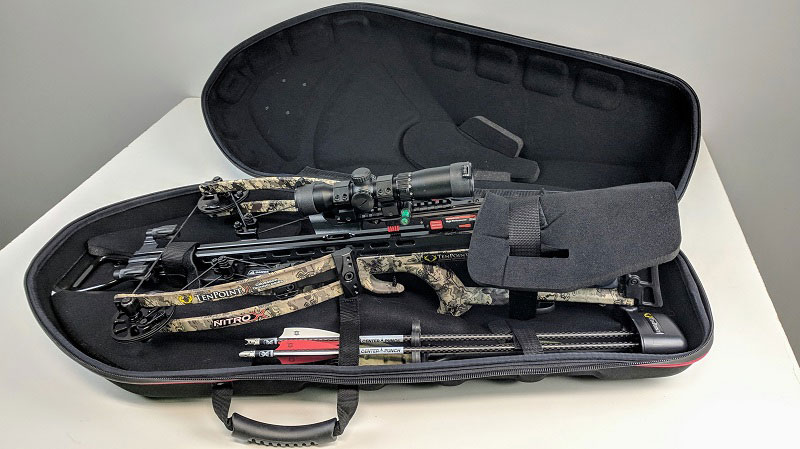
The TenPoint STAG Hard Crossbow Case safely and securely stores your crossbow during the off-season. (Author photo)
— PAID PARTNER CONTENT. This content is brought to you by a D&DH advertising sponsor.
____________________
[embedded content]


